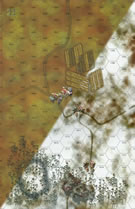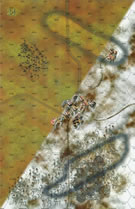|
Festival Day: Foy-Notre-Dame, East of Dinant, Belgium Britain's Bulge #2 |
||
|---|---|---|
|
(Attacker)
Britain
(Attacker) United States |
vs | Germany (Defender) |
| Formations Involved |
|---|

| Total | |
|---|---|
| Side 1 | 2 |
| Draw | 0 |
| Side 2 | 0 |
| Overall Rating, 2 votes |
|---|
|
3
|
| Scenario Rank: --- of 913 |
| Parent Game | Britain's Bulge |
|---|---|
| Historicity | Historical |
| Date | 1944-12-25 |
| Start Time | 08:15 |
| Turn Count | 30 |
| Visibility | Day |
| Counters | 97 |
| Net Morale | 0 |
| Net Initiative | 2 |
| Maps | 3: 22, 23, 24 |
| Layout Dimensions | 84 x 43 cm 33 x 17 in |
| Play Bounty | 192 |
| AAR Bounty | 171 |
| Total Plays | 2 |
| Total AARs | 1 |
| Battle Types |
|---|
| Inflict Enemy Casualties |
| Urban Assault |
| Conditions |
|---|
| Randomly-drawn Aircraft |
| Reinforcements |
| Scenario Requirements & Playability | |
|---|---|
| Britain's Bulge | Base Game |
| Elsenborn Ridge | Maps + Counters |
| Liberation 1944 | Counters |
| Introduction |
|---|
|
Christmas morning dawned bright and clear. That morning 3rd RTR and 8th/Rifle Brigade were ordered east to attack the villages of Sorinne and Boisseilles. There they would meet up with the U.S. 2nd Armored Division and keep on moving southeast. The advance would be made with two squadrons up: B Squadron on the north route to Sorinne, C Squadron on the south route to Boisseilles, and A Squadron in reserve to follow B Squadron. A platoon of the Rifle Brigade had been attached to A and B Squadrons, and a section of the regiment’s Recce troop attached to C Squadron. At dawn on Christmas Day the battalion drove a German picket out of Boisseilles before reaching Foy-Notre Dame on the flank of the U.S. 82nd Armored Reconnaissance Battalion. |
| Conclusion |
|---|
|
At 0820, sixteen Shermans of 3rd RTR’s C Squadron, a platoon from 8th/Rifle Brigade and a section of recce troops in Bren carriers moved south along the east bank of the Meuse and then advanced east towards Boisseilles (south of Foy-Notre-Dame and northwest of Celles). The column drew fire and made a dash down a forward slope into the village, losing one Recce tank (a Stuart VI) but taking Boisseilles along with some prisoners. The bag included an armored car, a halftrack, a truck and a jeep. However, the position was unpleasant as the village was overlooked by a wooded hill to the northeast (Bois de Geauvelant), occupied by four German tanks, including one Panther. A Firefly maneuvered into position and eventually got a few shots in, whereupon the Panther pulled back. B Squadron advanced from Dinant and moved east to Sorinne without much difficulty. They knocked out three Panthers and some infantry and then shot up more German vehicles and took prisoners around Foy-Notre-Dame. They then linked up with the U.S. 2nd Armored Division’s 82nd Armored Reconnaissance Battalion. With forces of three nations in the area, the situation was often confusing and when the 82nd made contact with a British unit they fired upon it and destroyed a British Sherman which was advancing towards their lines. The British were then ordered to remain in place. The Brits had a grandstand view as the US 2nd Armored Division’s Combat Command B Task Force A and swarms of USAAF fighter-bombers swept through the area towards Celles. An over-enthusiastic P38 pilot strafed the British column but fortunately there was only one casualty. On the U.S. side, Task Force A with Shermans in front advanced southwest towards the Bois de Geauvelant with little opposition. As the task force emerged from the trees it came under fire from the farm east of Foy-Notre-Dame and lost three halftracks. The Americans called for air support and P38s bombed/strafed four Panther tanks, temporarily putting them out of action. The column again drew fire near Boisseilles, from the same Panthers which had earlier fired on the British. Two platoons (ten Shermans) of the U.S. 67th Armored Regiment moved in and destroyed three Panthers. By the middle of the afternoon Task Force A had reached the high ground overlooking Celles, blocking the roads to the west and southwest. Battle Groups von Böhm and Cochenhausen had been completely cut off with no chance of rescue. Battle Group Cochenhausen’s crews abandoned or destroyed their vehicles and retreated to the east on foot. |
| AFV Rules Pertaining to this Scenario's Order of Battle |
|---|
|
| 7 Errata Items | |
|---|---|

|
All Bren carriers should have a movement value of 7. (Shad
on 2010 Dec 15)
|

|
The "Optional Values" for the Firefly given in an Avalanche Press Daily Content piece on the 17-Pdr Anti-Tank gun (and printed on a replacement counter sheet Download) are now the Official Ratings, published in games like Cassino '44, Grossdeutschland 1946, and Indian Unity. These are: 5-5 / 8-8 Full Strength and 3-5 / 8-8 Reduced Strength. (caryn
on 2012 May 03)
|

|
Two 105mms (ID#s 1204, 1205) have "16-31" fire values in black (direct fire), when they should be in white (indirect fire). (Shad
on 2010 Dec 15)
|

|
The reduced direct fire value of the Heer HMG became 5-5 starting with Fall of France. (plloyd1010
on 2015 Jul 31)
|

|
All SS PzIVH tanks should have a movement of 8. (Shad
on 2010 Dec 15)
|

|
The morale and combat modifiers of German Sergeant #1614 should be "0", not "8". (Shad
on 2010 Dec 15)
|

|
All SPW 251s have an armor value of 0. (Shad
on 2010 Dec 15)
|
| What else can go wrong? | ||||||||||||
|---|---|---|---|---|---|---|---|---|---|---|---|---|
I'm not much into writing AARs, but this scenario was a bit problematic. The Germans lost within just 3 turns although I played on until turn 8. This list shows the problems facing them in my play. 1- They were hit with a Logistics Shortfall on turn 1, 2- The Second Armored arrived on time on turn 2, 3- They were then hit with a Critical Logistics Shortfall on turn 3! This left the Germans fairly powerless in the face of the British advances. |
||||||||||||
| 0 Comments |

 BBoB001
BBoB001 





































